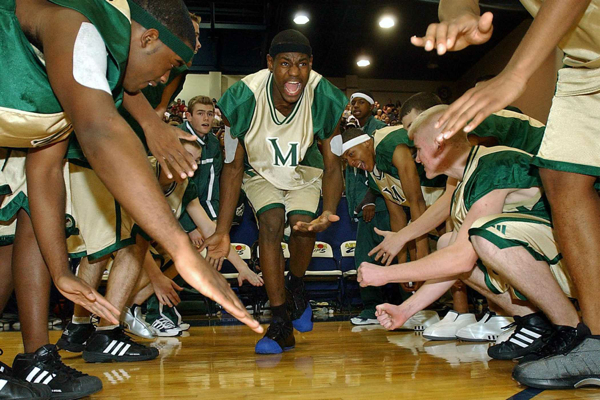Movie review by Greg Carlson
An inspirational documentary covering the remarkable maturation process of a group of Akron, Ohio basketball players including NBA superstar LeBron James, “More Than a Game” makes up in heart what it lacks in depth. Sure to invite comparisons to Steve James’ 1994 “Hoop Dreams,” “More Than a Game” focuses more attention on high stakes seasons and national rankings than it does questioning the surreal transformation of James from talented high school athlete of deficient financial means to household name/corporate brand/multi-millionaire. Viewers seeking a penetrating examination of the ethics of contemporary sports culture won’t find it among the many images that reinforce a mostly wholesome and largely sanitized Horatio Alger-like telling of the American Dream.
Filmmaker and Akron native Kristopher Belman was only a young film student at Loyola Marymount when he proposed a smaller project on the close-knit team of ballplayers who began working together before junior high. Through the inclusion of plenty of fuzzy home video footage, audiences experience the prowess of the protagonists from elementary school to the end of their senior year. One of the movie’s uncanny delights is watching the little boys grow up, and the movie’s multi-year span affords the spellbinding pleasure of seeing literal physical transformation before our eyes.
To Belman’s credit, “More Than a Game” spends at least some quality time with each member of the squad, even if LeBron is the main attraction. An unselfish player with dazzling passing skills, James extends his magnanimity to the other members of the Akron Fab Four (later Fab Five with the addition of moody outsider Romeo Travis). Coach Dru Joyce II and his son Dru Joyce III emerge as key figures, and the film accentuates the diminutive younger Joyce’s tenacity on the court as well as the elder Joyce’s struggle to be an effective coach and father to his driven offspring.
Critical viewers will long for a closer, off-the-court examination of the players and their backgrounds. James, who by necessity became a seasoned and cautious interview subject when he was still a teenager, talks about growing up without a father and sometimes having to stay with a coach instead of his mother Gloria, who was only 16 when LeBron was born, but the film offers no substantive information beyond James’ initial mention. Belman, who is white, elects to bypass any discussion of race, a theme that might have enlarged and toughened the portrait. We learn that the teammates elected not to attend a predominantly African American school in favor of the private, more affluent St. Vincent-St. Mary, but no additional examination of the related politics is entertained.
Belman also does not address James’ unsuccessful petition to enter the NBA draft following his junior year and the impact that decision had on his friends and teammates. By the time James appeared on the cover of “Sports Illustrated,” he and the other Fighting Irish starters had already developed plenty of cocky swagger, but Belman’s only acknowledgment of the dangers of hubris comes courtesy of the section recounting the team’s state title loss to tougher Division II high school Roger Bacon in 2002. Of course, with James listed as one of the movie’s executive producers, one shouldn’t expect the story to stray too far from confirmatory acclamation. Despite the deliberate omissions, “More Than a Game” is required viewing for any basketball fanatic.
